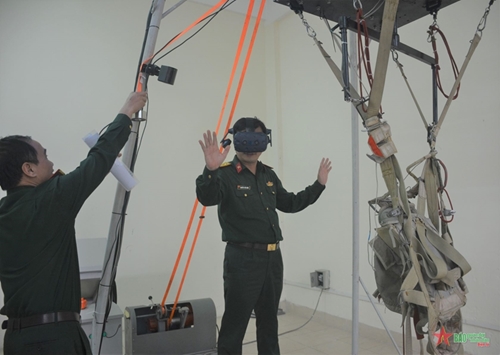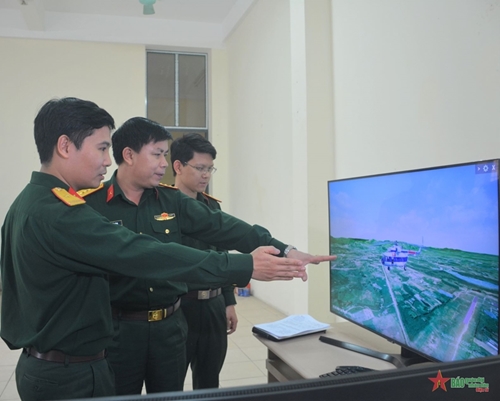The product was the result of the “Cooperation in researching, designing, mastering the technology of manufacturing a three-dimensional virtual reality parachute training system” project, conducted by Major Le Anh, Senior Captain Pham Minh Kha, and Major Phan Hoang Cuong.
    |
 |
|
The authors test their new product. |
The research project is nominated for the first prize of the 23rd Military Creative Youth Award. The system has been tested at the National Center for Aerial Search and Rescue Training of the Staff of the Air Defense - Air Force Service (ADAF) and highly appreciated by the unit. Approved by functional agencies of the Ministry of National Defense, the new system, at present, is manufactured and put into service at several units of the ADAF.
Earlier, after conducting surveys at the Air Defense - Air Force Service, the team found that the current training system does not meet the higher demand for upskilling and training. They realized that it is possible to master the design and manufacture a new parachute training system that is as good as those of foreign countries, suitable to Vietnam’s conditions, familiar with Vietnamese trainees, and at a reasonable price, thereby ensuring military secrecy, saving costs, and reducing incidents in training.
    |
 |
|
Major Le Anh (left), chief author of the project, introduces the new product. |
After all-out efforts, the inventors from the MTA have successfully developed the 3D virtual reality parachute training system.
The made-in-Vietnam system has the capability of training and inspecting new trainees’ actions, including leaving the aircraft exit door and opening and maneuvering the parachute in two exercises, namely three-second stable parachuting and stable parachuting with combat gears under 30kg.
Major Le Anh, chief author of the project, said that the new training system equipped with 3D virtual reality technology was born to provide trainees with vivid images and motions close to reality. Troops, when using this system, will feel like skydiving in real condition. Thanks to the simulated training system, trainees will not feel like a fish out of water and be able to handle all circumstances while parachuting and to reach the right position required by the commanding officer.
To create the most realistic 3D space, the authors utilized VR technology in 3D modelling, so that troops can see and notice the surrounding space like they are standing near the aircraft exit door and observing around.
One of the most highly-appreciated advantages of the system is mental skills training, thereby minimizing risks and uncertainties during training sessions.
According to Major Le Anh, troops are given an opportunity to train both mental and tactical skills when using the new parachute training system designed closely to the current conditions in the Vietnam People’s Army. Moreover, the features of the made-in-Vietnam system are equivalent to those of other countries’ modern products but at a more reasonable price. In addition, the product was built to be easily updated and changed to better meet new mission requirements.
The newly-invented 3D virtual reality parachute training system is considered a new breakthrough of the VPA’s engineering industry and expected to be further developed in the future.
Translated by Cong Nguyen